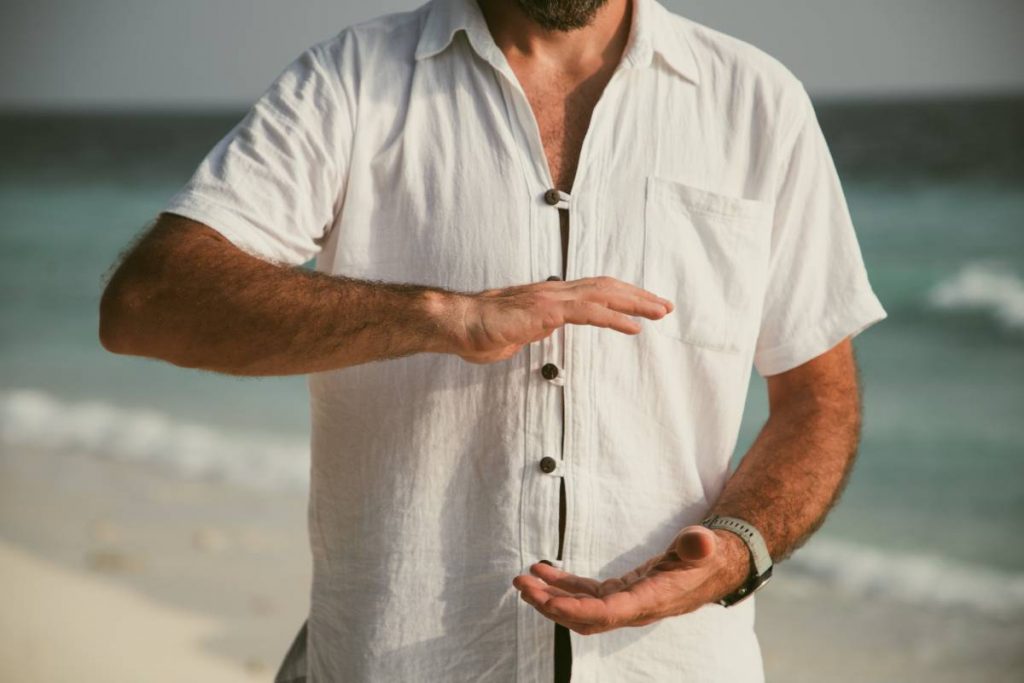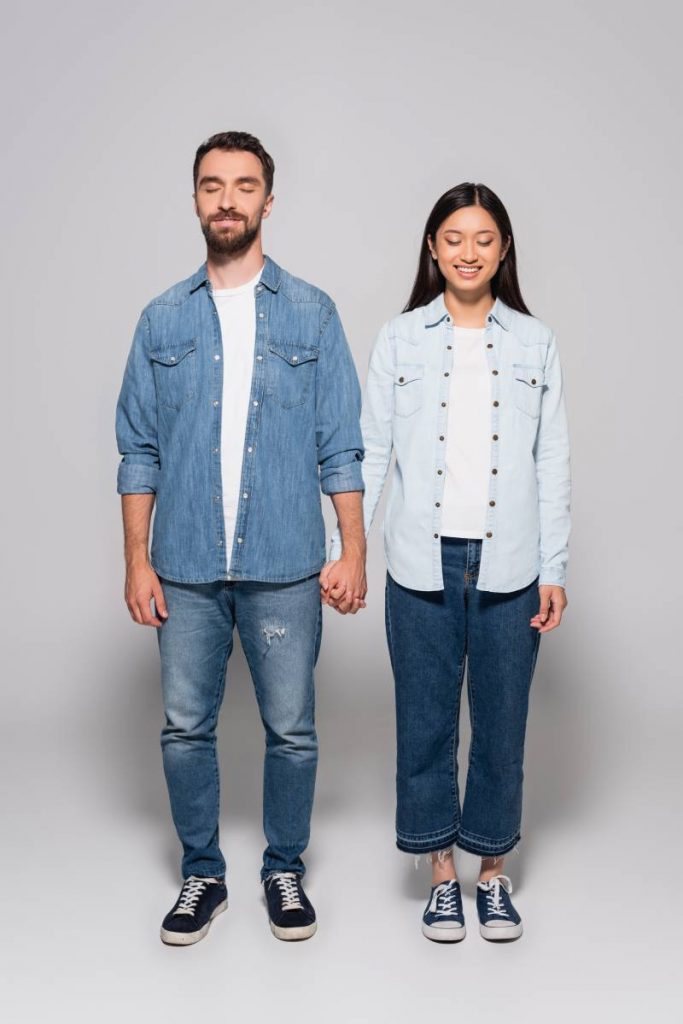Summer is here, and it’s hot outside! Finding clothes that keep you cool and look good is a must. Some people say that wearing black in the sun makes you feel even hotter, but is that true? And what fabrics should you wear during hot weather?
It can be hard to know what to choose when it comes to summer fashion. But don’t worry! In this article, we’ll explain the science behind clothing choices and give you some practical tips to help you pick the perfect summer outfit.
You might also read:
Does a black shirt really make you hotter?
Have you ever heard the claim that wearing a black shirt on a sunny day will make you feel hotter? It’s a common belief, but let’s dive into the science to see if there’s any truth to it.
Firstly, the colour black is known to absorb more light and heat compared to lighter colours. This is because black objects absorb most of the visible light spectrum, rather than reflecting it as lighter colours do. So, intuitively, it might seem logical that wearing black on a sunny day could lead to feeling warmer.
However, when it comes to clothing, several factors come into play that complicate this simple relationship between colour and heat. Fabric type, thickness, and breathability all influence how much heat is retained by clothing.

In reality, what matters most is not the colour of the clothing but rather its fabric and its ability to absorb and release heat. For example, a loose-fitting, lightweight white cotton shirt may actually keep you cooler than a tight-fitting, thick black polyester shirt, despite the colour difference.
The key factor here is how well the fabric allows air to circulate around your body and how effectively it wicks away moisture (sweat) to aid in the cooling process. Fabrics like cotton and linen are known for their breathability and moisture-wicking properties, making them great choices for hot weather regardless of their colour.
Moreover, the environment you’re in plays a significant role in how your clothing affects your body temperature. If you’re in a dry, arid climate, wearing black might indeed make you feel hotter due to its heat-absorbing properties. However, in a more humid environment, where sweat evaporation plays a crucial role in cooling the body, the colour of your clothing becomes less significant compared to its breathability and moisture-wicking ability.
It’s also essential to consider cultural and psychological factors. In many cultures, black clothing is associated with formality or mourning, leading people to wear it in situations where they might already feel uncomfortable or sombre, such as at funerals or formal events. This association could contribute to the perception that black clothing makes you feel hotter, even if the colour itself isn’t the primary factor.
In short, while it’s true that black clothing absorbs more light and heat than lighter colours, the overall impact on your body temperature depends on a variety of factors, including fabric type, thickness, breathability, and environmental conditions. So, the next time you’re deciding what to wear on a hot day, don’t sweat it too much about the colour—opt for lightweight, breathable fabrics that will help you stay cool and comfortable regardless of whether they’re black, white, or any other colour of the rainbow.
Which fabric is best for hot weather?
When the sun is blazing and the temperature soars, your choice of clothing fabric can make all the difference between feeling comfortable and sweltering in the heat. Let’s explore some of the best fabrics for hot weather and why they’re ideal for keeping you cool.
Cotton
Known for its breathability and softness, cotton is a go-to fabric for hot weather. It absorbs moisture (like sweat) from your skin and allows it to evaporate, helping to keep you dry and cool. Cotton garments are lightweight and comfortable to wear, making them perfect for casual outings or everyday wear in warm climates.

Linen
Made from the fibres of the flax plant, linen is another excellent choice for hot weather. It’s lightweight, breathable, and has natural moisture-wicking properties. Linen fabric allows air to circulate around your body, promoting ventilation and helping to keep you feeling fresh and cool. While linen clothing may wrinkle easily, its airy feel more than makes up for it, making it a popular option for summer dresses, shirts, and trousers.
Rayon
Rayon is a semi-synthetic fabric made from natural cellulose fibres, often derived from wood pulp. It’s lightweight, breathable, and has excellent moisture-wicking properties, making it suitable for hot and humid climates. Rayon drapes well and has a silky feel, making it a stylish choice for blouses, dresses, and skirts.
Bamboo
Bamboo fabric, also known as bamboo viscose or bamboo rayon, is derived from bamboo plants. It’s soft, breathable, and has natural antimicrobial properties that help to keep odour at bay. Bamboo fabric wicks moisture away from the skin and dries quickly, making it a fantastic option for activewear, underwear, and socks in hot weather.
Polyester
While polyester is not a natural fibre like cotton or linen, modern polyester blends are designed to be lightweight, moisture-wicking, and quick-drying, making them suitable for hot weather. Polyester garments are often used in athletic wear and outdoor clothing for their durability and ability to keep you cool and dry during physical activity. However, some people may find polyester less breathable than natural fibres, so it’s essential to look for blends that incorporate moisture-wicking properties.
Silk
Silk is a luxurious natural fibre known for its softness and lustrous appearance. While it may not be the first fabric that comes to mind for hot weather, silk has excellent moisture-wicking properties and regulates body temperature well, making it suitable for both warm and cool climates. Silk garments are lightweight and breathable, making them an elegant choice for summer dresses, blouses, and scarves.
When it comes to choosing the best fabrics for hot weather, prioritize breathability, moisture-wicking properties, and lightweight construction. Cotton, linen, rayon, bamboo, polyester blends, and silk are all excellent options that can help you stay cool and comfortable when the temperature rises.
So, whether you’re heading to the beach, going for a hike, or simply enjoying a sunny day outdoors, choose clothing made from these fabrics to beat the heat with style and ease.
What fabrics should be avoided in hot weather?
When the summer sun beats down and the heat becomes unbearable, your choice of clothing can either help you stay cool or leave you feeling like you’re trapped in a sauna. To ensure you don’t end up sweating buckets, here are some fabrics you should avoid in hot weather and why they’re not the best options for staying cool and comfortable.
Synthetic Fabrics like Polyester and Nylon
While modern synthetic fabrics are designed to be lightweight and moisture-wicking, many still have drawbacks that make them less than ideal for hot weather. Polyester and nylon, in particular, are not as breathable as natural fibres like cotton or linen. They tend to trap heat and moisture against the skin, leading to discomfort and potential chafing. If you’re going to be out in the sun for an extended period, it’s best to steer clear of clothing made from these synthetic materials.
Heavy Wool
Wool is a fantastic insulator, which is great for keeping you warm in cold weather. However, it’s not so great when the temperatures start to soar. Heavy wool garments can feel stifling and uncomfortable in hot weather, as they trap heat and don’t allow for adequate airflow. If you need to wear wool in the summer, opt for lightweight, breathable blends or merino wool, which is known for its moisture-wicking properties.
Faux Leather and Vinyl
While faux leather and vinyl may add a trendy edge to your wardrobe, they’re not the best choices for hot weather. These synthetic materials don’t breathe like natural fabrics, meaning they can trap heat and sweat against your skin, leading to discomfort and even skin irritation. If you want the look of leather without the heat, consider opting for breathable alternatives like cotton or linen.
Thick Denim

Denim is a classic fabric that never goes out of style, but thick denim jeans or jackets can be downright unbearable in hot weather. Denim is heavy and doesn’t allow for much airflow, making it a poor choice for staying cool when the temperatures rise. If you can’t bear to part with your denim, look for lighter-weight options or styles with strategic ventilation, like cropped jeans or denim shorts.
Tightly Woven Fabrics
Fabrics with tight weaves, such as canvas or twill, can be stifling in hot weather because they don’t allow for much airflow. While these fabrics may be durable and long-lasting, they’re not the best choice when you’re trying to beat the heat. Instead, opt for lighter, more breathable fabrics like cotton or linen, which will help you stay cool and comfortable all summer long.
Silk (in certain situations)
While silk is a luxurious fabric known for its softness and lustrous appearance, it’s not always the best choice for hot weather. Silk doesn’t absorb moisture well and can leave you feeling sweaty and clammy in hot, humid conditions. If you do choose to wear silk in the summer, opt for lightweight, breathable styles and be prepared for potential discomfort on especially hot days.
Conclusion
In summer fashion, fabric selection is crucial for comfort and well-being in the heat. Despite beliefs about black clothing absorbing heat, it’s actually a fabric’s breathability and moisture-wicking properties that are key. Cotton, linen, rayon, and bamboo stand out for their lightness and ability to keep us cool. On the other hand, synthetic materials, heavy wool, and dense weaves can cause discomfort and overheating. Choosing fabrics that offer comfort and breathability allows for a stylish and cool summer, embracing the warmth of the sun with ease.





